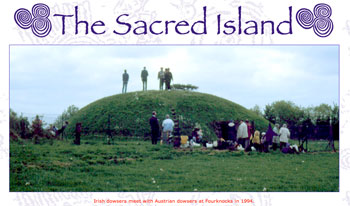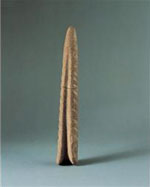
1"Four Knocks: Sun, Moon and Uranus." The Hedge Druid. Web. 02 Apr. 2011. <http://www.hedgedruid.com/2010/06/four-knocks-sun-moon-and-uranus/#more-6271>.
2Tour companies active in this area include Boyne Valley Tours, and Native Spirit Tours.

3Fourknocks Passage Tomb. 31 May 2010. Information sign at the site. Stamullen.
4The story of the expulsion of Elcmar from Brú na Bóinne by the "druid-enchantments" of Aenhus is a Celtic myth which in its present form dates from about the time of Christ.
Herity, Michael. Irish Passage Graves: Neolithic Tomb-builders in Ireland and Britain, 2500 B.C. New York: Barnes & Noble, 1975. 1.
5"Fourknocks (Passage Grave) | Ireland | The Modern Antiquarian.com." Stone Circles, Megalithic Remains, Prehistoric Sites | The Modern Antiquarian.com. Web. 02 Apr. 2011. <http://www.themodernantiquarian.com/site/891/fourknocks.html>.
In an email communication 4/1/2011, Mr.
Padraig Clancy of the Antiquities Department at the National Museum of Ireland suggested that the specific conversation referenced in the citation above may be contained in a newspaper clipping in the Fourknocks topograpical file.
6Hartnett, P. J. "Excavation of a Passage Grave at Fourknocks, Co. Meath." Proceedings of the Royal Irish Academy Section C: Archaeology, Celtic Studies, History, Linguistics, Literature 58 (1956/1957): 197-98.
7Hartnett 12.
More recently archaeologist Carleton Jones interpreted the evidence to indicate that the wooden beams presumed attached to a central post did indeed support the stones and capstone of a fully-corbelled roof. (Jones, Carleton. Temples of Stone: Exploring the Megalithic Tombs of Ireland. Cork: Collins, 2007. 94.)
8Harbison, Peter. Guide to National and Historic Monuments of Ireland: including a Selection of Other Monuments Not in State Care. Dublin: Gill and Macmillan, 1992. 261.
9Hutton, Ronald. The Pagan Religions of the Ancient British Isles: Their Nature and Legacy. Oxford, UK: B. Blackwell, 1991. 55-57.
1010Archaeologist Carleton Jones suggests that marble-size chalk balls found in the Fourknocks excavation, similar to those found in other tombs, may have been used within a ritual practice of placing the marbles into the cupmarks or other decorations on the stones. "Perhaps they were the 'eyes' of spirits or ancestors, which were only opened by performing particular rituals." (Jones, Carleton. Temples of Stone: Exploring the Megalithic Tombs of Ireland. Cork: Collins, 2007. 100.)
Martin Dier doubts that the megalithic artist intended to create a representation of a face. "When dealing with a culture as clearly sophisticated as is evident from the careful positioning of the massive stones, it is unlikely that they produced a crude face when clearly they could manage much more difficult tasks."
(Dier, Martin. "Fourknocks An Interpretation by Martin Dier." Knowth.com. Web. 2 Apr. 2011. <http://www.knowth.com/fourknocks-mdier.htm>.)
11Hartnett 222.
12Thomas, Julian. "Monuments from the Inside: The Case of the Irish Megalithic Tombs." World Archaeology Monuments and the Monumental 22.2 (1990): 175.
13Hartnett 241-43.
14"Carved Stone." National Museum of Ireland. Web. 02 Apr. 2011. <http://www.museum.ie/en/list/artefacts.aspx?article=624061c1-9b53-464e-a1d6-d71a9c77b27c>.

15Cooney, Gabriel. "A Tale of Two Mounds: Monumental Landscape Design at Fourknocks." Archaeology Ireland 11.2 (Summer, 1997): 18-19.
16Underwood, Guy. The Pattern of the Past. New York: Abelard-Schuman, Ltd., 1972. 91-2.
17Dier, Martin. "Fourknocks An Interpretation by Martin Dier." Knowth.com. Web. 2 Apr. 2011. <http://www.knowth.com/fourknocks-mdier.htm>.